The Toymaker
Information from Matryoshka (audio story)
These omissions are so great that the article's factual accuracy has been compromised. Check out the discussion page and revision history for further clues about what needs to be updated in this article.
- You may be looking for Celestial Puppet Master or the Gamemaster.
The Toymaker, also known as the Celestial Toymaker, was a powerful being who ensnared sentient beings in seemingly childish games, with their freedom as the stakes. However, the Toymaker hated to lose and the games were always rigged in his favour.
His origins were mysterious, apparently by his own design, (AUDIO: The Nightmare Fair [+]Loading...["The Nightmare Fair (audio story)"]) with his possible origins including a "renegade Time Lord, corrupt Guardian, bored Eternal, or human-descended entity from the end of time". (GAME: The Celestial Toymaker [+]Loading...["The Celestial Toymaker (game)"]) According to some accounts, the Toymaker was the Guardian of Dreams, one of the six Guardians of Time, a group of Great Old Ones. (PROSE: Divided Loyalties [+]Loading...["Divided Loyalties (novel)"]) Where the other five Guardians were each associated with a colour, the Guardian of Dreams was associated with crystal. (PROSE: The Quantum Archangel [+]Loading...["The Quantum Archangel (novel)"]) The Toymaker was known to the Chinese as the trickster-god No Cha. (PROSE: Christmas on a Rational Planet [+]Loading...["Christmas on a Rational Planet (novel)"]) As a member of the Pantheon, he was "the God of Games". (TV: The Legend of Ruby Sunday [+]Loading...["The Legend of Ruby Sunday (TV story)"])
The Toymaker was a long-standing enemy of the Doctor, playing at least three games against them over millennia. (TV: The Celestial Toymaker [+]Loading...["The Celestial Toymaker (TV story)"], The Giggle [+]Loading...["The Giggle (TV story)"])
The Toymaker had a sister named Hecuba, who was known as the Queen of Time, (AUDIO: The Queen of Time [+]Loading...["The Queen of Time (audio story)"]) and a child known as Maestro, who embodied music instead of games and disliked their father. Both the Toymaker and Maestro were recognised by the Fifteenth Doctor as members of the Pantheon. (TV: The Devil's Chord [+]Loading...["The Devil's Chord (TV story)"])
Biography[[edit] | [edit source]]
Origins[[edit] | [edit source]]
"Whatever the Toymaker is" was a deeply mysterious question with many possible answers. (GAME: The Celestial Toymaker [+]Loading...["The Celestial Toymaker (game)"]) According to the Sixth Doctor, "nobody [knew]" who the Toymaker really was. He was said to be "old beyond imagining" and to predate "Time Lord records". The team of modern Gallifreyan researchers who later attempted to "chart his path through Time" gave up, bored of all the games he played with his own past. The Doctor speculated that they didn't try any harder than that because they couldn't find a way to control him. (AUDIO: The Nightmare Fair [+]Loading...["The Nightmare Fair (audio story)"])
Indeed, one account showed the Toymaker acknowledging different origins in conversation with Adric and with the Doctor, once even altering the details of his story mid-conversation. (PROSE: Divided Loyalties [+]Loading...["Divided Loyalties (novel)"]) Auteur noted that liking the records of themselves "all muddled up" was one of the things they had in common. (PROSE: The Two Auteurs [+]Loading...["The Two Auteurs (short story)"]) The Toymaker's species and place of origin were listed as simply "???" in the data files of the Doctor's TARDIS. (PROSE: TARDIS Data File: The Toymaker [+]Loading...["TARDIS Data File: The Toymaker (feature)"])
As a being from another universe[[edit] | [edit source]]
Though disagreeing on the details, a number of accounts attributed the Toymaker's powers to his being a native of a different universe than the Doctor's own.
While facing the Toymaker in Blackpool, the Sixth Doctor came to believe that he had finally cracked the riddle of the Toymaker's origins, deducing that the Toymaker originated in another universe and was "hurled" into the Doctor's universe by some kind of "catastrophe". This would explain his longevity, and, more broadly speaking, his being immune to the usual laws of physics. The Toymaker did not confirm or deny the theory, but he did corroborate the Doctor's conclusion that the Toymaker had lived for "millions of years". He then seemed to bear his soul to him, and told him that for the first few "thousands of millennia" he spent in the Doctor's universe, he used his powers to build and assist civilisations — creating "ships, continents, whole planets even". However, he eventually got bored, until only mindless destruction could give him any satisfaction at all; after an equal length of time spent destroying everything he had previously built up, he discovered games as his final and lasting distraction, as they allowed him to embrace nihilism without falling into inactive apathy, surrendering all to the whims of chance.
Although it was key to the Sixth Doctor's theory that the Toymaker was the sole survivor of his universe, (AUDIO: The Nightmare Fair [+]Loading...["The Nightmare Fair (audio story)"]) its broad lines echoed the Sixth and Seventh Doctors' explanations of the nature of the Great Old Ones in other accounts, as a specific group of beings who had escaped the destruction of their universe by jumping into the Doctor's own at the moment of Event One. These accounts did not mention the Toymaker, but (PROSE: Millennial Rites [+]Loading...["Millennial Rites (novel)"], All-Consuming Fire [+]Loading...["All-Consuming Fire (novel)"]) later accounts lumped the Toymaker in with a pantheon of "Elder Gods" also including the likes of Fenric, (AUDIO: Black and White [+]Loading...["Black and White (audio story)"]) loosely matching the earlier list of Great Old Ones. (PROSE: Millennial Rites [+]Loading...["Millennial Rites (novel)"], All-Consuming Fire [+]Loading...["All-Consuming Fire (novel)"])
In fact, some accounts claimed that the Toymaker was the crystal-coloured Guardian of Dreams, counterbalancing the other five Guardians of Time, the most powerful Great Old Ones who had survived from a destroyed universe in which they had been an earlier race of Time Lords. (PROSE: Divided Loyalties [+]Loading...["Divided Loyalties (novel)"], The Quantum Archangel [+]Loading...["The Quantum Archangel (novel)"]) Six Guardians were stated in one account as having been in attendance for the creation of the universe. (PROSE: The Whoniverse [+]Loading...["The Whoniverse (novel)"])
While trying to win Adric to his side in an account which otherwise treated him as a Great Old One and Guardian, the Toymaker claimed: "I, too, am from another universe, Adric. Born elsewhere and forced to live out my life in a place not my own". Later in the conversation with Adric, he seemingly changed his story, now claiming to be a voluntary exile in the manner of the Doctor, though he specified that he was not a Time Lord. However, this same account also saw the Toymaker identifying himself as a Great Old One and the Guardian of Dreams to the Doctor and Stefan. (PROSE: Divided Loyalties [+]Loading...["Divided Loyalties (novel)"])
As a being from outside time and space[[edit] | [edit source]]
Yet another account simply suggested that the Toymaker originated from "outside time and space". (PROSE: Doctor Who Character Encyclopedia: Updated Edition [+]Loading...{"page":"35","1":"Doctor Who Character Encyclopedia: Updated Edition (reference book)"})
According to the Eighth Doctor, the Toymaker came from "the Dark Places", (COMIC: Endgame [+]Loading...["Endgame (DWM comic story)"]) also home to the Mara, (TV: Kinda [+]Loading...["Kinda (TV story)"], Snakedance [+]Loading...["Snakedance (TV story)"]) who would later be cited as one of the same pantheon as the Toymaker. (TV: The Legend of Ruby Sunday [+]Loading...["The Legend of Ruby Sunday (TV story)"]) The Dark Places were "another dimension" with ties to the darker aspects of consciousness, a "stilled heart-beat away" from the conventional universe. (TV: Kinda [+]Loading...["Kinda (TV story)"], COMIC: The Body in Question [+]Loading...["The Body in Question (comic story)"])
One source saw the Fourteenth Doctor describe the Toymaker as an "elemental force" with "the power of a god", and suggested that he originated outside the universe; he described the Toymaker's domain as "another realm, a hollow beneath the Under-Universe". In this account, the Toymaker and the Doctor both suggested that the Toymaker had never properly "entered" the Doctor's world before his battle with the Fourteenth Doctor. (TV: The Giggle [+]Loading...["The Giggle (TV story)"])
This source suggested that the Fourteenth Doctor had accidentally summoned the Toymaker into reality by casting salt at the edge of the universe (TV: The Giggle [+]Loading...["The Giggle (TV story)"], Wild Blue Yonder [+]Loading...["Wild Blue Yonder (TV story)"]) where he had recently met more primitive beings who referred to themselves as "not-things" and exhibited a range of powers, including reshaping and resizing themselves. They claimed to have come from the nothing which existed beyond the edge, being shaped by distant echoes of the thoughts and lives of the universe's inhabitants. Having been shaped by these echoes of "war and blood and fury and hate", their sole burning desire was to enter reality, "play [mortals'] vicious games, and win". This ethos (TV: Wild Blue Yonder [+]Loading...["Wild Blue Yonder (TV story)"]) echoed the linked account's depiction of the Toymaker as holding that "all that exists is to win or to lose", hence placing games above the Doctor's notions of good and evil. (TV: The Giggle [+]Loading...["The Giggle (TV story)"]) The Fifteenth Doctor later inferred that the Goblins followed the Toymaker into the universe as part of his legions; after he defeated the Goblins, they appeared to either be erased from existence or be pulled back into another world. (PROSE: The Church on Ruby Road [+]Loading...{"page":"100, 137","chaptnum":"Thirteen and Eighteen","1":"The Church on Ruby Road (novelisation)"})
As a native of the Doctor's universe[[edit] | [edit source]]
Some accounts suggested the Toymaker was not extradimensional, but simply an ancient and powerful native of the Doctor's universe, possibly a survivor of the Dark Times, a member of the Doctor's own kind, or both.
The First Doctor believed the Toymaker to be one of many. By his understanding, the Toymaker he encountered was native to the same universe as himself, and had "lasted" for "thousands of years" by the time of their first encounter. He told Steven Taylor and Dodo Chaplet that "this Toymaker" was "immortal, like all toymakers", explaining that "the urge to create toys that are ultimately destructive [was] unfortunately part of [their] universe", such that the world was metaphorically full of "destructive toymakers" like him. (PROSE: The Celestial Toymaker [+]Loading...["The Celestial Toymaker (novelisation)"])
The Sixth Doctor was drawn to Blackpool believing that he had detected the presence of "the Nexus of the Primeval Cauldron of Space-Time itself" there. Upon coming face-to-face with the Toymaker, he realised that he had been detecting the Toymaker himself, and deduced that the Toymaker had "set up the Space-Time Vortex", to which the Toymaker corrected: "Doctor, I am the Space-Time Vortex". (PROSE: The Nightmare Fair [+]Loading...["The Nightmare Fair (novelisation)"], AUDIO: The Nightmare Fair [+]Loading...["The Nightmare Fair (audio story)"]) When Peri Brown marvelled at the thought of the Toymaker as "a being the Time Lords couldn't handle", the Doctor, who had yet to come up with his later theory about the Toymaker being from another universe pointed out that "there [were] lots of them… Time Lords generally aren't very good at handling things, especially themselves". (AUDIO: The Nightmare Fair [+]Loading...["The Nightmare Fair (audio story)"])
The Twelfth Doctor claiming that the Toymaker was spawned in the chaos before time. (COMIC: Relative Dimensions [+]Loading...["Relative Dimensions (comic story)"]) Likewise the Seventh Doctor described the Toymaker as an Elder God originating from the Old Times at the beginning of the universe. (AUDIO: The Magic Mousetrap [+]Loading...["The Magic Mousetrap (audio story)"], Black and White [+]Loading...["Black and White (audio story)"]) In fact, one account equated him with the Chinese trickster-god No Cha, depicting him as one of the magical entities from the chaotic "time before this" who had survived the Time Lords' imposition of rationality upon the universe. Only when rationality's foothold on the universe lessened, such as during the reign of the Carnival Queen, was the Toymaker able to descend from his realm outside time and space, and interfere in the physical world once again. (PROSE: Christmas on a Rational Planet [+]Loading...["Christmas on a Rational Planet (novel)"])
In contrast, one account mentioned the "chap" who became "obsessed with games" and took to dressing like a Chinese mandarin as a member of one of the elder races from the original palimpsest universe; in this account, this original state of reality before the Great Houses' interference was one of perfect linearity, and it was only after the introduction of time travel to the universe that various members of the elder races went mad and turned their powers to evil or mischief. (PROSE: Mr Saldaamir [+]Loading...["Mr Saldaamir (short story)"])
By one account, in addition to the aforementioned possibility of him being a corrupt Guardian, other possibilities were that the Toymaker had originated as a renegade Time Lord, a "bored Eternal", or a "human-descended entity from the end of time". (GAME: The Celestial Toymaker [+]Loading...["The Celestial Toymaker (game)"]) His realm was also likened to Faeryland, with one account suggesting that he might have followed rules similar to the traditional fae. (GAME: The Gunfighters [+]Loading...["The Gunfighters (game)"])
Auteur believed that the being Mortimus had once described as "a being of vast mental powers, who could build and destroy entire realms with his mind", (PROSE: The Two Auteurs [+]Loading...["The Two Auteurs (short story)"]) namely the Toymaker, (PROSE: Divided Loyalties [+]Loading...["Divided Loyalties (novel)"]) had originally been a fellow Archon from the early history of their people, specifically Urizen's game-master. When Urizen and the other early Archons began to plan the anchoring of the universe along the rules of logic, the game-master dissented, wanting to use the rules of play as the organising principle instead. In the moment of anchoring, (PROSE: The Two Auteurs [+]Loading...["The Two Auteurs (short story)"]) although he successfully "wove" his "urge to build destructive toys" into "the very fabric of the Universe itself", ensuring his own immortality, (PROSE: The Book of the Snowstorm [+]Loading...["The Book of the Snowstorm (short story)"]) he realised that the other founders' insistence on the rules of logic were diluting his own vision. As a result, still infused with the power of the caldera, he "packed his bag and stomped off to the cosmic basement to make his own universe". He was subsequently forgotten, with the records of his existence becoming "muddled up, just how he likes them". (PROSE: The Two Auteurs [+]Loading...["The Two Auteurs (short story)"])
Creating the Celestial Toyroom[[edit] | [edit source]]
According to the First Doctor, the Toymaker succeeded in creating a universe of his own, "entirely in his own vision" called the Celestial Toyroom, where he would "manipulate people and turn them into his playthings". The Toymaker and his games became "notorious throughout the universe" as he spread his influence to attract people into his world and try to make them part of it. (PROSE: The Celestial Toymaker [+]Loading...["The Celestial Toymaker (novelisation)"])
Out of boredom, (COMIC: The Greatest Gamble [+]Loading...{"page":"41","1":"The Greatest Gamble (comic story)"}) the Toymaker began spending centuries of his time wandering the Earth and sampling its various games, (PROSE: The Nightmare Fair) frequently challenging humans from across history. He lured people from a variety of cultures to the Toyroom, turning them into toys when they lost his games. (COMIC: The Greatest Gamble [+]Loading...{"page":"39-42","1":"The Greatest Gamble (comic story)"}) In the 18th century, Hsen Ling told stories of his own abduction by the trickster-god No Cha, who he beat in an unearthly game of cards. (PROSE: Christmas on a Rational Planet [+]Loading...["Christmas on a Rational Planet (novel)"])
Meeting the Doctor[[edit] | [edit source]]
The First Doctor's encounter with the Toymaker alongside Steven Taylor and Dodo Chaplet was not his first, with the two's interactions implying at least two — and potentially more — prior encounters, although one of them was very brief. (TV: The Celestial Toymaker [+]Loading...["The Celestial Toymaker (TV story)"]) One account purported to depict the Doctor and the Toymaker's first-ever encounter, at a time when the Doctor was still a student at Prydon Academy, having only recently begun to go by "the Doctor". (PROSE: Divided Loyalties [+]Loading...["Divided Loyalties (novel)"]) This encounter neither involved the Doctor turning around at once, nor playing the "chairs" game, marking it out as distinct from, and even earlier than, the encounters discussed in the prior account. (TV: The Celestial Toymaker [+]Loading...["The Celestial Toymaker (TV story)"], PROSE: Divided Loyalties [+]Loading...["Divided Loyalties (novel)"])
The Time Lords' data banks on the Toymaker on Gallifrey during the Doctor's early life described him only as a vague legend, with some reports implying that there existed several Toymakers rather than just one. When the First Doctor investigated the legend with his friends Rallon and Millennia in a stolen TARDIS, they arrived in the Toyroom and found the Toymaker in a dormant, disembodied state. However, he managed to possess Rallon and make Millennia one of his living toys, with the Doctor able to best him with the help of the Dymova. Knowing that he would become an even more worthy opponent given time to mature, the Toymaker allowed the Doctor to leave the Toyroom. (PROSE: Divided Loyalties [+]Loading...["Divided Loyalties (novel)"])
When initially meeting what their old "handsome" school-mate had become, Auteur did not actually realise that he had merged with the ancient being of the same name, believing him to have simply taken on a renegade's title as several other members of their generation had done. At that time, having become "sole supplier of toys to all of Fairyland", he was calling himself "the Wonderful Toymaker" and claiming to himself be a fairy. (PROSE: The Two Auteurs [+]Loading...["The Two Auteurs (short story)"]) Indeed, another account compared the Toymaker's realm to "Faeryland" and suggested that he might have followed fae rules. (GAME: The Gunfighters [+]Loading...["The Gunfighters (game)"]) The next time he and Auteur met prior to Auteur's twelfth regeneration, he had started claiming to be a Great Old One, (PROSE: The Two Auteurs [+]Loading...["The Two Auteurs (short story)"]) as he would still maintain when meeting the Sixth Doctor. (PROSE: Divided Loyalties [+]Loading...["Divided Loyalties (novel)"]) The Goddess of Gendar, Auteur's twelfth incarnation, found both claims ridiculous. However, she was later told by her future self about the relationship between the "old egomaniac needy game-player, and [the] young egomaniac needy game-player". According to the future Auteur, it had not been a straightforward possession; in fact, the two elementals had merged outright, leaving "just the one schizoid liar"; as Auteur put it, "Pinocchio [had] become Gepetto". (PROSE: The Two Auteurs [+]Loading...["The Two Auteurs (short story)"])
Indeed, although Rallon's individuality would later reassert itself in full — much to the distress of what remained the original "pure" Toymaker — their consciousnesses had substantially merged, with the Toymaker's personality and behaviour being influenced by Rallon's own. (PROSE: Divided Loyalties [+]Loading...["Divided Loyalties (novel)"])
This body is being sustained by him. Me. Whatever. Here, let me explain. I needed a body — sadly my original one did not… suit this Universe. Your friend's is the first I have come across that isn't enfeebled and prone to wearing out every seventy years. Mortality is such a burden, I find. This one could last a good thousand years I should imagine. (…) I think there is a tiny spark of him somewhere inside me, acting as a cohesion to keep this frame together.
His servant Stefan would go on to observe broad aspects of the Toymaker's personality which were actually part of Rallon's, including "a sense of morality, of good and evil"; without him the Toymaker was "cold and harsh". (PROSE: Divided Loyalties [+]Loading...["Divided Loyalties (novel)"])
Early encounters with the Doctor[[edit] | [edit source]]
Shortly after the First Doctor, Steven Taylor and Dodo Chaplet's arrival in the Celestial Toyroom, the Toymaker recalled that in his and the Doctor's immediately prior encounter, after landing in the Toyroom, the Doctor had "hardly had time to turn around", instead of staying and playing the Toymaker's games, much to the Toymaker's disappointment. (TV: "The Celestial Toyroom" [+]Part of The Celestial Toymaker, Loading...{"namedep":"The Celestial Toyroom","1":"The Celestial Toymaker (TV story)"})
You're so innocent, Doctor. The last time you were here, I hoped you'd stay long enough for a game, but you had hardly time to turn around.
Some of the Doctor's remarks in the subsequent games suggested at least one additional prior encounter in which the Doctor had interacted with the Toymaker at greater length and engaged in his games, with the Doctor expressing familiarity with the "chairs" game on sight. (TV: "The Hall of Dolls" [+]Part of The Celestial Toymaker, Loading...{"namedep":"The Hall of Dolls","1":"The Celestial Toymaker (TV story)"}) In turn, by that point, the Toymaker was quite familiar with the quirks of the Doctor's personality, remarking and playing upon the fact that the Doctor was "so insatiably curious" that the Toymaker "knew" making the TARDIS scanner screen blank would "bring [him] out". (TV: "The Celestial Toyroom" [+]Part of The Celestial Toymaker, Loading...{"namedep":"The Celestial Toyroom","1":"The Celestial Toymaker (TV story)"})
Continued activities[[edit] | [edit source]]
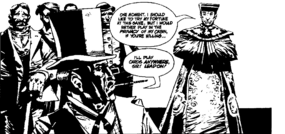
On one of many occasions when he tricked game-players from across human history into playing games with him, he lured Gaylord Lefevre — a professional gambler from the Old West — from his steamboat in the Mississippi, challenging him to a game of cards; when Gaylord's luck began to sour he attempted to mark the cards to "even the score", but, aware of Gaylord's deception, the Toymaker proclaimed that the game was forfeit and transformed him into one of his many toys after playing along briefly. He later challenged a Roman soldier, leading him past the toy version of Gaylord. (COMIC: The Greatest Gamble [+]Loading...{"page":"39-42","1":"The Greatest Gamble (comic story)"}) This account showed him already looking as he later would during his rematch with the First Doctor; (COMIC: The Greatest Gamble [+]Loading...["The Greatest Gamble (comic story)"], TV: The Celestial Toymaker [+]Loading...["The Celestial Toymaker (TV story)"]) by one account which acknowledged Gaylord, he only gained that body — Rallon's — after his first encounter with a younger Doctor, placing those events after that encounter.
At some point between his first encounter with the Doctor and his encounter with the Fifth Doctor, the Rallon-merged Toymaker had an encounter with Mortimus, whom the Toymaker rather liked. (PROSE: Divided Loyalties [+]Loading...["Divided Loyalties (novel)"])
At some point, the Toymaker sired a child, Maestro, who embodied "the essence of music" as much as their father embodied a game. Though sharing their father's theatricality and distinctive laugh, they came to dislike him, speaking resentfully of how the Toymaker had "daddied them". Maestro themself had a child known as Henry Arbinger, who served as Maestro's Harbinger, (TV: The Devil's Chord [+]Loading...["The Devil's Chord (TV story)"]) beings who accompanied the members of the Pantheon. (TV: The Legend of Ruby Sunday [+]Loading...["The Legend of Ruby Sunday (TV story)"])
Rematch with the First Doctor[[edit] | [edit source]]
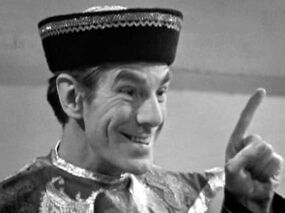
After compiling a list of games to play, (PROSE: The Traveller From Beyond Time [+]Loading...{"page":"21","1":"The Traveller From Beyond Time (short story)"}) the Toymaker drew the Doctor's TARDIS to his realm, so he could make the Doctor play his games again with his companions, Steven Taylor and Dodo Chaplet, but arranged things so that the Toyroom would vanish completely at their moment of victory, leaving him the only survivor and the Doctor and his companions his subjects forever. (TV: The Celestial Toymaker [+]Loading...["The Celestial Toymaker (TV story)"]) However, Rallon was able to keep the Toymaker's powers in check and ensured that he abided by the rules of his games to help the Doctor to escape. (PROSE: Divided Loyalties [+]Loading...["Divided Loyalties (novel)"]) The Doctor soon outwitted the Toymaker again and escaped, leaving his realm in chaos, and the Doctor believing that the Toyroom no longer existed, (TV: The Celestial Toymaker [+]Loading...["The Celestial Toymaker (TV story)"]) but the Toymaker later stated that he had actually been banished to the ether for millennia after his defeat. (COMIC: Endgame (part three) [+]Loading...{"part":"Three","1":"Endgame (DWM comic story)"}) One account suggested that the Celestial Intervention Agency had maneuvered the First Doctor into his confrontation with the Toymaker in the interests of Gallifreyan security. (PROSE: The Universal Databank [+]Loading...["The Universal Databank (reference book)"])
One account raised the possibility that the Toymaker may have gotten his revenge sooner than not: (GAME: "Who Changed History?" [+]Part of The Gunfighters, Loading...{"namedpart":"Who Changed History?","1":"The Gunfighters (game)"}) in eating a sweet he'd gotten from the Toymaker's realm, (TV: The Gunfighters [+]Loading...["The Gunfighters (TV story)"]) the Doctor may have failed to follow the rules of Faeryland and allowed the Toymaker to take control of his destiny again. Thus, the Toymaker's influence may have been the reason why the First Doctor's subsequent adventure in Tombstone, Arizona differed from the "historical version" of the gunfight at the O.K. Corral. In fact, one possibility was that "the whole town of Tombstone [was] another illusionary game created by the Toymaker as a last trap for the Doctor…". (GAME: "Who Changed History?" [+]Part of The Gunfighters, Loading...{"namedpart":"Who Changed History?","1":"The Gunfighters (game)"})
Playing chess with Daleks[[edit] | [edit source]]

At one time, the Toymaker's dimension took the form of a "strange-looking plan, all made from coloured wood and angular blocks" which was actually the bottom of a humongous "toy box". The "vast landscape" was dotted with doll's houses and various giant living toys in service of the Toymaker, including a number of Toy Soldiers and two giant teddy bears. The most salient feature of that toy box was a giant chessboard, on which he made a group of Daleks he'd ensnared compete with a group of adventurers whose TARDIS he'd subsequently drawn out of the Vortex — a group which may have included the First Doctor or sundry other possibilities.
With the Daleks being determined to destroy the Toymaker's dimension if they were freed, it was likely destroyed in the aftermath, and one possible outcome was that the Toymaker would be forced to abandon it altogether, stealing the Daleks' ship and eventually washing up on mediaeval Earth. Upon scouting out said village in the course of their own journeys, the escaped adventurers would soon discover the rumours about "the King's new toymaker" who was said to be a "warlock".(GAME: A Game of Daleks [+]Loading...["A Game of Daleks (game)"])
Visit to the Shadow Dimensions[[edit] | [edit source]]
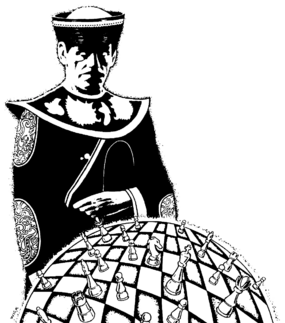
At some point, "the Mandarin" began tracking the Entity through the Arabian plains, intending to challenge him to a game, but was unable to as the Entity was "hurled" into a non-world, (PROSE: Games [+]Loading...{"page":"22","1":"Games (short story)"}) the Shadow Dimensions, by the Doctor, (PROSE: The Curse of Fenric [+]Loading...["The Curse of Fenric (novelisation)"]) and so he had to travel to the non-world to challenge him there instead. After agreeing on the stakes — the Mandarin would relinquish his body to the Entity if he lost or the Entity would become the Mandarin's toy if he were to lose instead — the Entity chose four dimensional chess as the game of choice. After playing for an unknowable duration of time, the advantage swaying between them, the Mandarin realised, towards the endgame, that he was going to lose, so, for the first time, he was able to comprehend the concept of a stalemate. After such an event happened, the Entity demanded a rematch, but the Mandarin declined explaining they were equally matched rendering a rematch pointless, and thus left the non-world, thanking the Entity for teaching him that "perhaps winning [wasn't] everything after all." (PROSE: Games [+]Loading...{"page":"22","1":"Games (short story)"})
Becoming the Mandarin[[edit] | [edit source]]
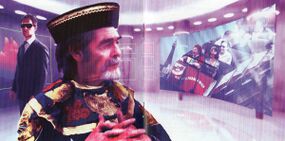
When the Toymaker discovered that Rallon's body was dying after centuries of existence, he set out to ensnare the Doctor again and hatched a complex plot to turn his companions against him and absorb the Fifth Doctor as a new host, but was thwarted when Rallon forced himself to undergo multiple regenerations consecutively, with the trauma expelling the Toymaker from his body. A projection of Rallon's potential future self then merged with the Toymaker to ensure that his full powers continued to be kept under control. While waiting for his Toyroom to repair itself, the Toymaker decided to take his servant Stefan to Earth to seek amusement, deciding to go to Blackpool from an idea he had seen in Tegan Jovanka's mind.
By this account, although the Toymaker had meaningfully regenerated, in a way which altered his personality, he kept the same face as before; (PROSE: Divided Loyalties [+]Loading...["Divided Loyalties (novel)"]) this tallied with one account of the Doctor's subsequent encounter with the Toymaker in Blackpool, (PROSE: The Nightmare Fair [+]Loading...["The Nightmare Fair (novelisation)"]) while another, otherwise-similar account of this event showed that the new Toymaker had adopted a different physical appearance and voice altogether, (AUDIO: The Nightmare Fair [+]Loading...["The Nightmare Fair (audio story)"]) which he would retain during an encounter with the Eighth Doctor. (AUDIO: Solitaire [+]Loading...["Solitaire (audio story)"])
The Mandarin in Blackpool[[edit] | [edit source]]
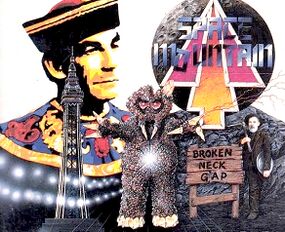
Whichever face he wore, the Toymaker began operating in late 20th-century Blackpool, indulging in the same impulse that had led to his wanderings. Using the Space Mountain thrill-ride as his base-of-operations, he instructed Stefan, as well as Yatsumoto and others, to begin the development of arcade cabinets with video games that killed the players that failed with an electronic monster projected from the video screen. The Toymaker goaded the Sixth Doctor and Peri Brown into a series of traps and games while they were on holiday in Blackpool. However, when the Doctor recognised the Toymaker's infinite loneliness, the Toymaker was agitated enough to cheat the Doctor of his game and use the video game's murderous monster to kill him, but he was thwarted by the combined intervention of Peri and his other surviving prisoners. To ensure his video games could never be released to harm the people of Earth, the Doctor turned one of the neural relays the Toymaker had built to passively redirect his telekinetic energy against its creator, using it to trap the Toymaker in an endless mental time loop sustained by his own mental energy. The Doctor believed that the Toymaker could not escape from such a fate until his body finally died of old age after uncountable millions of years; the Doctor confessed to Peri that he was quite aggrieved to have had no other option but to visit such a "loathsome" fate upon his ancient foe. (PROSE: The Nightmare Fair [+]Loading...["The Nightmare Fair (novelisation)"], AUDIO: The Nightmare Fair [+]Loading...["The Nightmare Fair (audio story)"])
Time loop trap[[edit] | [edit source]]
Info from Matryoshka [+]Loading...["Matryoshka (audio story)"] needs to be added
The Seventh Doctor's trap[[edit] | [edit source]]
"Stirred up" by Fenric as part of a game among the Elder Gods, (AUDIO: Gods and Monsters [+]Loading...["Gods and Monsters (audio story)"]) the Toymaker lured several people into his domain, including the Seventh Doctor and his companions Ace and Hex. Working under the Doctor's leadership, the group of victims were apparently successful in defeating the Toymaker and imprisoning his essence in a doll. Each of them ate a piece of the doll, dividing the Toymaker so that he would no longer be capable of using his powers. The Doctor concocted an elaborate plan to keep control over the fragments of the Toymaker in the minds of each member of the group until the Toymaker withered away forever. As this plan involved the Doctor forgetting having made the plan in the first place, he wound up short-circuiting it. In the end, it was revealed that the Toymaker had been in control all along, allowing himself to be absorbed into humanity so that he could "feel what it was like to lose". Finally, one of the people involved, the chess master Swapnil Khan, managed to trap the Toymaker in a seemingly-perpetual stalemate in his own dimension, but not before the Toymaker had reduced everyone except the Doctor, Ace, Hex, and Khan's daughter, Queenie Glasscock, to wooden dolls. (AUDIO: The Magic Mousetrap [+]Loading...["The Magic Mousetrap (audio story)"])
Facing the Eighth Doctor and Charley[[edit] | [edit source]]
In an account which depicted him in the same persona encountered by the Sixth Doctor in Blackpool, (AUDIO: The Nightmare Fair [+]Loading...["The Nightmare Fair (audio story)"]) the Toymaker captured the Doctor's TARDIS and took it to his Toyshop, where he transformed the Eighth Doctor into a puppet and the Doctor's companion, Charley Pollard, was forced to take part in his riddle, but was tricked by the Toyshop, which shrunk to 0% of its original size and the body the Toymaker was using was destroyed within it. The Toymaker swore that when his new body had formed, he would take his revenge upon the Doctor and Charley, who had escaped before the Toyshop's destruction. (AUDIO: Solitaire [+]Loading...["Solitaire (audio story)"])
Facing the Eighth Doctor and Izzy[[edit] | [edit source]]
Info from Murder in the Dark, & Trick or Treat needs to be added
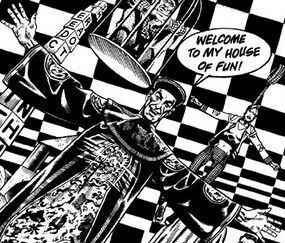
According to one account which purported to be the Toymaker's first encounter with the Doctor after his defeat at the Trilogic Game, the Toymaker, having been banished to the ether in his defeat, spent millennia searching for a way to best the Doctor, eventually finding that the Imagineum would be able to create a version of the Doctor under his bidding that was more powerful than the original. As the Imagineum had been in a spacecraft that crashed on Earth and looted by the Knights Templar, the Toymaker played and won a game of canasta with a descendant of the Templar living in the 1990s named Marwood, placing him under his bidding and the Imagineum in his possession. However, Marwood's adjutant, Felix, stole a component of the Imagineum called the Focus, and entrusted it with Maxwell Edison and Izzy Sinclair, before he was killed by Marwood in a mirror version of Stockbridge the Toymaker made, while keeping the real village in a Macro-Dimensional Linkage Device that resembled a snowglobe.
When the Eighth Doctor arrived in the fake Stockbridge, the Toymaker confronted him when he, Max and Izzy tried to retreat to his TARDIS. While the Doctor and Izzy were able to escape from his clutches, Max was captured, and taken to the Macro-Dimensional Linkage Device that the Toymaker had sealed the real Stockbridge in. When the Doctor and Izzy mounted a rescue from the Toyroom, the Toymaker had Marwood and his dolls capture them, and forced them to play games of snakes and ladders and hangman before the Toymaker unveiled his possession of the Imagineum. The Toymaker placed Izzy and Max in a game of mousetrap and created his duplicate of the Doctor, placing them in a game of gladiatorial chess.
Despite his duplicate being physically superior to him, the Doctor was able to convince his duplicate not to fight by explaining that he was merely just another one of the Toymaker's playthings. After seeing the Toymaker murder Marwood after growing bored of him, the duplicate of the Doctor was left with no doubt that he too would eventually befall the same fate, so he turned on the Toymaker, going to kill him, but the Doctor instead used the Imaginuem to create a duplicate of the Toymaker, sending him and his duplicate to compete in a perpetual stalemate in the Dark Places where the Toymaker originated. As the Toyroom began to dissipate, the Doctor, Izzy, and Max fled, while the Doctor's duplicate remained so he could destroy the Imagineum, and the Doctor restored Stockbridge after Max took the "snowglobe" with him from the Toyroom. (COMIC: Endgame [+]Loading...["Endgame (DWM comic story)"])
Playing with the Tenth Doctor[[edit] | [edit source]]
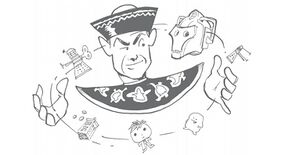
The Toymaker attempted to persuade a victim to play the Trilogic Game, while speaking about his toys and their sadness, as he toyed with the Tenth Doctor, the TARDIS, a Cyberman, an Adipose, and some Daleks. (POEM: The Toymaker [+]Loading...{"page":"32-33","1":"The Toymaker (poem)"})
Encounter with the Twelfth Doctor[[edit] | [edit source]]
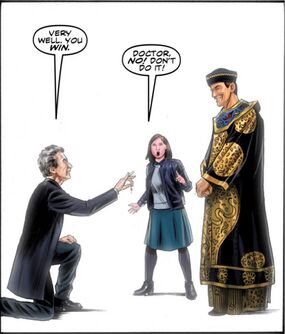
In an account which ostensbly took place long after the Last Great Time War but depicted the Toymaker with the same appearance as during his seminal encounter with the First Doctor, after the Toyroom began to break down due its ancient age, the Toymaker feared that he would be "loose in a wild, unforgiving universe", thus luring the Twelfth Doctor and Clara Oswald on the pretence of a party hosted by Susan, wanting to steal the Doctor's TARDIS to keep the Toyroom contained. After the toy replicas of some of the Doctor's previous companions failed to capture him, the Toymaker flew a toy biplane towards him and Clara; as the Toymaker's power over the Toyroom was waning, the Doctor was able to take some control, causing the biplane to crash by hitting it with a giant bauble.
The Doctor and the Toymaker then battled with toy armies until he realised they were equally matched, deciding to propose a game of Truth or Dare; it was in this game the Toymaker revealed his fears about the Toyroom's collapse and, thinking he was outsmarting the Doctor, dared him to give the TARDIS to him. As the TARDIS materialised around the Toyroom, the Doctor and Clara travelled to the control room, rebuilding the Toyroom with the Zero Room and ejecting it into space. The Doctor had felt compassion for the Toymaker, for they weren't so dissimilar: "a lonely god, drifting through time and space in his magical toy box." (COMIC: Relative Dimensions [+]Loading...["Relative Dimensions (comic story)"])
Facing the Fourteenth Doctor[[edit] | [edit source]]
Escape into the Doctor's universe[[edit] | [edit source]]
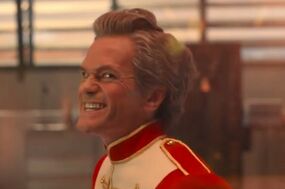
After the Fourteenth Doctor called upon the superstition of salt warding off evil to hold back the Not-things while at the edge of the universe, where "the walls [were] thin", (TV: Wild Blue Yonder [+]Loading...["Wild Blue Yonder (TV story)"]) the fact that he had "played a game" resulted in the Toymaker being "let in", entering the Doctor's universe with "delight". By then, the Toymaker had adopted a new appearance, a tall, blond-haired man who affected a variety of outfits and accents.
Running amok, the Toymaker played games with players across the universe, including the Guardians of Time and Space, whom he turned into voodoo dolls, and "God", whom he turned into a jack-in-the-box after gambling with Him. He would go on to claim to have "made a jigsaw out of [the Doctor's] history", a claim which shocked the Fourteenth Doctor, (TV: The Giggle [+]Loading...["The Giggle (TV story)"]) who was still distraught over what he had learned about apparently being the Timeless Child. (TV: Wild Blue Yonder [+]Loading...["Wild Blue Yonder (TV story)"]) He encountered the Spy Master, who was "dying", (TV: The Giggle [+]Loading...["The Giggle (TV story)"]) his body "failing" due his botched plan to hijack the Doctor's body through a forced regeneration. (TV: The Power of the Doctor [+]Loading...["The Power of the Doctor (TV story)"]) The Master "begged for his life with one final game", but he lost, whereupon the Toymaker imprisoned him inside his gold tooth "for all eternity". The only person the Toymaker avoided playing against was an entity he called "the One Who Waits", claiming to have "seen it hiding" and simply run away. (TV: The Giggle [+]Loading...["The Giggle (TV story)"])
Planting the Giggle[[edit] | [edit source]]
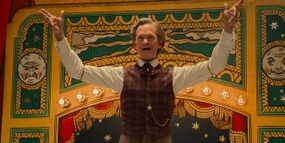
The Toymaker settled on Earth due to believing it and humanity were the "ultimate playground". In 1925, he set up a toy store and manipulated events which resulted in one of his dolls, Stooky Bill, becoming the first image viewed on a television screen. He also trapped Charles Banerjee in his domain after the latter lost a game with him, turning him partially into a doll. The Toymaker animated and immortalised the sound of Stooky Bill's laugh to spread insanity in the 21st century, as by then technology and communication had reached a point where the giggle could be heard subliminally across all screens across the planet.
The Toymaker in 1925 soon met the Fourteenth Doctor and Donna Noble, luring them into his domain. He taunted the Doctor with the number of people who had died because of him over the years, which enraged the Doctor enough to challenge him to a game of Cut with his personal cards. The Toymaker won, however, he was stopped from claiming his prize when the Doctor pointed out that, as he had beaten the Toymaker once before, this only counted as one-all in a best of three match. The Toymaker then swiftly disappeared to 2023, crumpling his toyshop into a box, with the Doctor and Donna in hot pursuit. (TV: The Giggle [+]Loading...["The Giggle (TV story)"])
The final game[[edit] | [edit source]]
The Toymaker arrived at UNIT HQ, entirely unthreatened by UNIT as he danced and lip-synced whilst slaughtering anybody who attempted to stop him. He took control of the galvanic beam UNIT had used to destroy the satellite broadcasting the giggle, and fired on the Doctor and his friends. When the Doctor attempted to persuade him to leave Earth and take his games elsewhere, the Toymaker refused, and then shot the Doctor with the beam, stating that the rules of the game state that he should play the final round with the next Doctor. The Toymaker watched in glee as the Doctor began to regenerate, but was dumbfounded when he instead bi-generated.
After causing the Fourteenth Doctor's bi-generation, the Toymaker engaged in an intense game of catch with the Fourteenth and Fifteenth Doctors. Finally, the Toymaker failed to catch a throw from the Fifteenth Doctor, and he was defeated. As his prize, the Fourteenth Doctor banished the Toymaker from existence forever. The Toymaker folded up into a suit that was contained in a box that Mel Bush pushed at him. As he was trapped, the Toymaker warned that "[his] legions [we]re coming." Kate Lethbridge-Stewart took the box and ordered UNIT to take it to their deepest vault and bind it in salt, (TV: The Giggle [+]Loading...["The Giggle (TV story)"]) while the Toymaker awaited within to start his next game. (PROSE: The Giggle [+]Loading...["The Giggle (novelisation)"]) The Toymaker's domain lingered for a short time afterwards which allowed the Fifteenth Doctor to cause a bi-generation of the TARDIS itself by claiming it as his own prize for defeating the Toymaker. (TV: The Giggle [+]Loading...["The Giggle (TV story)"])
Undated events[[edit] | [edit source]]
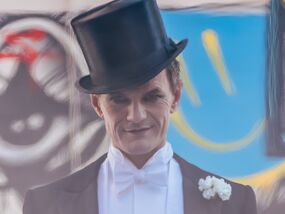
- Romana II once recalled an incident in which the Celestial Toymaker took over the BBC's Light Entertainment Department, greatly harming humanity but boosting sales figures. In order for her and the Fourth Doctor to defeat the Toymaker, Romana had to work at the BBC and produce a radio drama about cow owners. (PROSE: Doctor Who and the Krikkitmen [+]Loading...["Doctor Who and the Krikkitmen (novelisation)"])
- For an indefinitely prolonged period, the Fourth Doctor and Romana II were trapped in a hazy and simplistic reality in which they went on endless frivolous adventures, only occasionally having flashes of their true personalities. The Doctor once realised that he and Romana were dolls being played with until they fell apart, in the process seeing an "exquisitely carved Chinese mandarin doll" which he sensed was important. (PROSE: Playing with Toys [+]Loading...["Playing with Toys (short story)"])
- An image of the Toymaker as he appeared during his "Stooky Bill" plot, in his street-mime disguise, (TV: The Giggle [+]Loading...["The Giggle (TV story)"]) was the subject of the Fourteenth Doctor's request of a human to figure out the differences between two versions of reality following a "rupture in time" by examining two pictures. (GAME: Double Danger [+]Loading...{"page":"44","1":"Double Danger (game)"})
Legacy[[edit] | [edit source]]
Information from GAME: The Saviour of Time [+]Loading...["The Saviour of Time (video game)"], AUDIO: The Miniaturist [+]Loading...["The Miniaturist (audio story)"], Black and White [+]Loading...["Black and White (audio story)"] and The Widow's Assassin needs to be added.
The Elders, recording the First Doctor's voyages using their instruments and charts, included how the Celestial Toymaker showed the Doctor how gods were most dangerous when they were bored. (PROSE: The Traveller From Beyond Time [+]Loading...{"page":"20-21","1":"The Traveller From Beyond Time (short story)"})
On Siralos, the Tremas Master used "what was once the Celestial Toymaker's favourite toy" to trap the Graak. (GAME: Destiny of the Doctors [+]Loading...["Destiny of the Doctors (video game)"])
In the city-state Tor-Ka-Nom in 2708, after Izzy Sinclair retorted to the Eighth Doctor to "keep out of trouble", they both began citing trouble they got into, with the Doctor mentioning how she "almost got her neck stretched in a floating noose". (COMIC: By Hook or By Crook (part one) [+]Loading...{"part":"One","1":"By Hook or By Crook (comic story)"})
During the Eighth Doctor's supposed regeneration into a new incarnation, (COMIC: The Final Chapter (part four) [+]Loading...{"part":"Four","1":"The Final Chapter (comic story)"}) secretly the shapeshifting construct Shayde who had switched places with the real Doctor, (COMIC: Wormwood [+]Loading...["Wormwood (comic story)"]) an image of the Celestial Toymaker was seen. (COMIC: The Final Chapter (part four) [+]Loading...{"part":"Four","1":"The Final Chapter (comic story)"})
Upon Izzy's return home to Stockbridge on 19 December 1996, having felt guilty about how she treated her adoptive parents, they asked her about her day and she reminisced to herself about her adventures with the Doctor, including her first with the Toymaker. (COMIC: Oblivion (part six) [+]Loading...{"part":"Six","1":"Oblivion (comic story)"})
In mid-December 2008, upon being reunited with Maxwell Edison in Stockbridge, the Tenth Doctor reminisced about several of his adventures with Max, including how they defeated the Celestial Toymaker. (COMIC: The Stockbridge Child (part one) [+]Loading...{"page":"24","part":"One","1":"The Stockbridge Child (comic story)"})
When the Trylonians attempted to use their Brain Drain machine on the Eleventh Doctor to gain intel on their many enemies, the Celestial Toymaker was one of the individuals in the resulting mental projection who asked the Doctor for his help. (COMIC: The Birthday Boy [+]Loading...["The Birthday Boy (comic story)"])
While trapping the Thirteenth Doctor aboard his space platform, Zellin told the Doctor that her dimension was like a board game for him of which "the Toymaker would approve". (TV: Can You Hear Me? [+]Loading...["Can You Hear Me? (TV story)"])
The Fifteenth Doctor, after he and Ruby Sunday escaped from the Goblin ship, explained to her how the arrival of the Goblins was part of the Toymaker's legacy, as they were part of the legions he brought with him into the universe. (PROSE: The Church on Ruby Road [+]Loading...{"page":"100","chaptnum":"Thirteen","1":"The Church on Ruby Road (novelisation)"}) Indeed, they would later face the Toymaker's child Maestro, whom the Doctor identified to be part of a larger pantheon. (TV: The Devil's Chord [+]Loading...["The Devil's Chord (TV story)"]) Kate and UNIT, meanwhile, found supernatural threats to be an increasing issue. (TV: 73 Yards [+]Loading...["73 Yards (TV story)"]) When Sutekh returned, his Harbinger, Harriet, listed the other gods ostensibly under his command, citing "the Toymaker, the god of games" as first of the list. (TV: The Legend of Ruby Sunday [+]Loading...["The Legend of Ruby Sunday (TV story)"])
Other realities[[edit] | [edit source]]
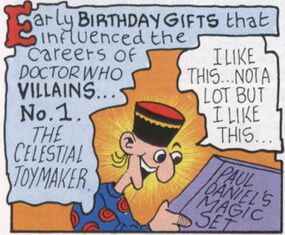
In Earth-33⅓, the Celestial Toymaker was a Doctor Who villain. Early in his career, he received an influential birthday present — a Paul Daniel's Magic Set — which he liked to an extent. (COMIC: Doctor Who? 196 [+]Loading...["Doctor Who? (DWM 196 comic story)","''Doctor Who?'' 196"])
In one of the infinite parallel universes of "possible space", (COMIC: Fire and Brimstone [+]Loading...["Fire and Brimstone (comic story)"]) the Doctor once encountered "the Toymaker", described as an "evil force dominating a fantasy world", in 2525. Barusa later discovered that the Toymaker was actually under the control of the Master. (PROSE: The Chronicles of Doctor Who? [+]Loading...["The Chronicles of Doctor Who? (short story)"])
Appearance[[edit] | [edit source]]
According to one account, before his first match with the Doctor, the Toymaker possessed countless other, less malleable bodies which wore out quickly under the strain. After three members of the Deca stumbled into his domain, he merged with the Time Lord Rallon. After stabilising in this new body, he was able to transform at will into other appearances. When he first greeted the young Doctor, he had taken the appearance of a red dragon, appearing as "a scaly, reptilian creature on four stumpy legs", "flame red all over" with "a big wide mouth, a scaly mane", "huge rolling eyes", and "a wisp of smoke curled out through one nostril".
He then revealed his humanoid appearance, dressed in the later-typical Chinese outfit. Notwithstanding when he was calling on his full power, when his head would blur into a starry "ball of energy", he initially had the face of the incarnation of Rallon with whom he had merged, handsome and youthful with olive skin and dark hair. However, after making the situation clear to the Doctor, he decided to alter it to better match his personality.
This new face was "lined, but seemingly through years of smiling rather than age" and "not unpleasant" — the form he wore (PROSE: Divided Loyalties [+]Loading...["Divided Loyalties (novel)"]) during his his encounter with the First Doctor, Steven Taylor and Dodo Chaplet. (TV: The Celestial Toymaker [+]Loading...["The Celestial Toymaker (TV story)"]) The young Doctor noticed his resemblance to "one of his teachers at Prydon Academy", (PROSE: Divided Loyalties [+]Loading...["Divided Loyalties (novel)"]) Councillor Hedin. (TV: Arc of Infinity [+]Loading...["Arc of Infinity (TV story)"]) This definitive Toymaker was a tall and imposing man with deep-set, glittering eyes. He dressed as a Chinese mandarin, wearing a round black hat with gold thread and a silver, red and blue collar over a dragon-patterned black robe encrusted with rubies, emeralds, diamonds and pearls. (PROSE: The Celestial Toymaker [+]Loading...["The Celestial Toymaker (novelisation)"]) Within the accounts of this particular encounter, the Toymaker was dressed in the theatrical Chinese outfit in the context of being the Doctor's opponnt in the Trilogic Game, much as his other living toys changed their outfits to match the theme of a given game; (TV: The Celestial Toymaker [+]Loading...["The Celestial Toymaker (TV story)"]) however, later accounts showed the Toymaker wearing this outfit as his regular everyday wear. (PROSE: Divided Loyalties [+]Loading...["Divided Loyalties (novel)"], The Nightmare Fair [+]Loading...["The Nightmare Fair (novelisation)"], COMIC: The Greatest Gamble [+]Loading...["The Greatest Gamble (comic story)"], AUDIO: The Nightmare Fair [+]Loading...["The Nightmare Fair (audio story)"], etc.) A later account showed the Toymaker changing his costume frequently to match his current entertanment. (TV: The Giggle [+]Loading...["The Giggle (TV story)"], PROSE: The Giggle [+]Loading...["The Giggle (novelisation)"])
After Rallon managed to separate himself from the Toymaker, the Toymaker merged with the Observer, Rallon's semi-independent Watcher. This allowed him to effectively regenerate into a new physical body replacing Rallon's original one, with Rallon's mind was no longer part of him, though his new body's personality would be influenced by the personality of Rallon's possible incarnations. The Fifth Doctor expected that the Toymaker would "look the same" despite the minor changes in demeanour; (PROSE: Divided Loyalties [+]Loading...["Divided Loyalties (novel)"]) by one account, he was proved correct when the Sixth Doctor met the Toymaker in Blackpool, with him still possessing the same "aristocratic bearing" as before. (PROSE: The Nightmare Fair [+]Loading...["The Nightmare Fair (novelisation)"]) Another telling of the same encounter, however, depicted the Toymaker as now having a distinctly different voice and appearance, with a graying beard and soulful, melancholy eyes. (AUDIO: The Nightmare Fair [+]Loading...["The Nightmare Fair (audio story)"])
In the form encountered by the Fourteenth Doctor, the Toymaker appeared as a blond man. He wore a number of different outfits based on his whims and the current situation. When first met in 2023 he wore a black top hat, tailcoat and trousers with a white bow tie and waistcoat as well as a plain white shirt. His outfit in 1925 were made up of a caramel brown leather apron, a single-breasted waistcoat of plum and sapphire tartan with a fob watch, a white and black pinstripe shirt, tan trousers, and white and brown spectator shoes. He also wore a shako and frock coat in scarlet and ivory with gold trims, beige breeches and ebony black boots with crimson laces when he terrorised UNIT, and then a black leather jacket with a khaki uniform and an ivory scarf as well as goggles when he took control of the galvanic beam; both events in London during 2023. (TV: The Giggle [+]Loading...["The Giggle (TV story)"])
Psychological profile[[edit] | [edit source]]
As the Toymaker was immortal, he would otherwise be incredibly bored if it weren't for his games; (COMIC: The Greatest Gamble [+]Loading...{"page":"41","1":"The Greatest Gamble (comic story)"}, PROSE: The Traveller From Beyond Time [+]Loading...{"page":"21","1":"The Traveller From Beyond Time (short story)"}) he therefore lived for these "times of chance", when both his skill and fortune were challenged, as it made eternity bearable. (PROSE: Games [+]Loading...{"page":"22","1":"Games (short story)"}) By one account, as he was isolated for so long, he had become insane; (PROSE: Doctor Who Character Encyclopedia: Updated Edition [+]Loading...{"page":"35","1":"Doctor Who Character Encyclopedia: Updated Edition (reference book)"}) indeed, the Twelfth Doctor was aware that people believed the Toymaker was insane, expressing that they were probably correct. (COMIC: Relative Dimensions [+]Loading...["Relative Dimensions (comic story)"]) According to the Sixth Doctor, games were the Toymaker's "meat and drink". (PROSE: Trick or Treat [+]Loading...{"page":"91","1":"Trick or Treat (short story)"})
Holding that "good" and "bad" were "nothing" to a being of his scale, he lived by the mantra that "all that exists is to win or to lose", (TV: The Giggle [+]Loading...["The Giggle (TV story)"]) losing all mirth if someone, even one of his servants, tried to plead or cheat their way out of suffering the consequences of "losing". (AUDIO: The Nightmare Fair [+]Loading...["The Nightmare Fair (audio story)"]) Several accounts showed that he had developed a particular affection for Earth and humanity due to their interest in games, (AUDIO: The Nightmare Fair [+]Loading...["The Nightmare Fair (audio story)"], TV: The Giggle [+]Loading...["The Giggle (TV story)"]) once declaring that he had "fallen in love with humanity". (TV: The Giggle [+]Loading...["The Giggle (TV story)"]) The Sixth Doctor believed that he had a specific "interest in matters Eastern", accounting for (AUDIO: The Nightmare Fair [+]Loading...["The Nightmare Fair (audio story)"]) his habit of dressing up as a Chinese mandarin, (TV: The Celestial Toymaker [+]Loading...["The Celestial Toymaker (TV story)"], AUDIO: The Nightmare Fair [+]Loading...["The Nightmare Fair (audio story)"], etc.) although another account suggested that the Toymaker made a habit of dressing up in outlandish costumes on a whim, occasionally playing up stereotypes associated with the costume he had appropriated to a cartoonish degree, such as fliting between various fake accents. (TV: The Giggle [+]Loading...["The Giggle (TV story)"])
The Toymaker once described himself as the "pan-dimensional" equivalent of Walt Disney, Charles Darrow, and Hiroshi Yamauchi. (PROSE: Divided Loyalties [+]Loading...["Divided Loyalties (novel)"]) The First Doctor berated him for his "childish behaviour", (TV: The Celestial Toymaker [+]Loading...["The Celestial Toymaker (TV story)"]) and he was prone to flitting rapidly between moods and ideas as the whim took him. (TV: The Giggle [+]Loading...["The Giggle (TV story)"], AUDIO: The Nightmare Fair [+]Loading...["The Nightmare Fair (audio story)"]) Occasionally the Toymaker would show a more serious side; he seemed truly disturbed by the notion of facing the One Who Waits, and showed anger and irritation during his confrontations with the Doctor. (TV: The Giggle [+]Loading...["The Giggle (TV story)"])
Though "wily" (COMIC: The Greatest Gamble [+]Loading...{"page":"41","1":"The Greatest Gamble (comic story)"}) he denied that he would cheat in his games, seeming genuinely offended by the suggestion. While the Fourteenth Doctor confirmed it was "the one thing he won't do" as "the rules of the game" were the only rules he would follow, the Toymaker would try to work outside the rules, such as trying to best the Doctor in a game of catch by throwing the ball without warning to catch the Doctor off-guard. (TV: The Giggle [+]Loading...["The Giggle (TV story)"]) By the time of his encounter with the Fifth Doctor, he took a dim view of the way the First Doctor tricked his way out of the Trilogic Game, lightly chiding the Doctor for cheating — though not so dim as to try to invalidate the outcome of that game. (PROSE: Divided Loyalties [+]Loading...["Divided Loyalties (novel)"]) One account, however, took it as a given that the Toymaker could not be trusted to "play fair". (GAME: A Game of Daleks [+]Loading...["A Game of Daleks (game)"])
The Toymaker also only wanted the Doctor's help if he could best him in a game, seemingly too proud to ask him directly. According to this account, the Toymaker was deathly afraid of the universe and could barely conceive the idea of being forced to leave the Toyroom. (COMIC: Relative Dimensions [+]Loading...["Relative Dimensions (comic story)"]) However, other accounts indicated he visited the outside universe without such fear. (COMIC: The Greatest Gamble [+]Loading...["The Greatest Gamble (comic story)"], PROSE: Games [+]Loading...["Games (short story)"], etc.) The concepts of evil and, up until a point, a stalemate were beyond his comprehension. (PROSE: Games [+]Loading...{"page":"22","1":"Games (short story)"})
Powers and abilities[[edit] | [edit source]]
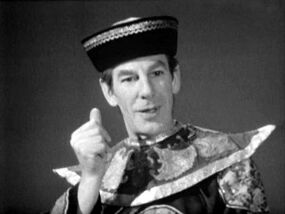
Within the Celestial Toyroom, the Toymaker commanded immense powers, but they were limited by the rules he or his opponents set for any particular game. (TV: The Celestial Toymaker [+]Loading...["The Celestial Toymaker (TV story)"]) The Fourteenth Doctor stated the Toymaker was bound by the rules, so much so that he could not cheat to win, even if he wanted to. He also had to follow new rules he brought into the game, even if the new rule did not gain him the result he was expecting, like how his desire to face the Fifteenth Doctor accidentally meant he also had to face the Fourteenth Doctor at the same time. (TV: The Giggle [+]Loading...["The Giggle (TV story)"]) Although, he could bend these rules or "forget" to mention them to his opponents if he so chose, (TV: The Celestial Toymaker [+]Loading...["The Celestial Toymaker (TV story)"]) although he was not above cheating if his opponent did also; on one occasion, he tauntingly claimed that he was just following a "new rule" his opponent had unwitingly introduced by cheating. (COMIC: The Greatest Gamble [+]Loading...{"page":"42","1":"The Greatest Gamble (comic story)"})
He himself was immortal and invulnerable, and appeared capable of space and time travel at will. (TV: The Celestial Toymaker [+]Loading...["The Celestial Toymaker (TV story)"], The Giggle [+]Loading...["The Giggle (TV story)"]) The Toymaker could control the gravity of the Toyroom (COMIC: The Greatest Gamble [+]Loading...{"page":"42","1":"The Greatest Gamble (comic story)"}) was able to fly, (COMIC: Relative Dimensions [+]Loading...["Relative Dimensions (comic story)"]) animate toys and render people invisible, (PROSE: Doctor Who Character Encyclopedia: Updated Edition [+]Loading...{"page":"35","1":"Doctor Who Character Encyclopedia: Updated Edition (reference book)"}) and teleport across space and time. (TV: The Giggle [+]Loading...["The Giggle (TV story)"]) He seemed to be able to travel from the Toyroom to other locations, and back, with ease. (COMIC: The Greatest Gamble [+]Loading...{"page":"40, 42","1":"The Greatest Gamble (comic story)"}, PROSE: Games [+]Loading...{"page":"22","1":"Games (short story)"}) Further more, he could change his clothes exceptionally fast, changing outfits when teleporting. (TV: The Giggle [+]Loading...["The Giggle (TV story)"])
During the course of a game, the Toymaker would gain total control over his player's lives and personalities, perpetually, if they lost the game or died outright. (TV: The Celestial Toymaker [+]Loading...["The Celestial Toymaker (TV story)"]) Apart from these children's games, the Toymaker sometimes played in person against his "guests", playing games such as cards, able to conjure his own deck and his own juggling balls. (TV: The Giggle [+]Loading...["The Giggle (TV story)"]) The Toymaker would be aware of if his opponent cheated and would reverse their actions before declaring the game forfeit and would have to pay a hefty price: becoming another one of his many toys within the Toyroom. (COMIC: The Greatest Gamble [+]Loading...["The Greatest Gamble (comic story)"]) The Toymaker also threatened the Doctor with "[his] legions", who would supposedly come for him after he was beaten by the Fourteenth and Fifteenth Doctors in a game of catch. (TV: The Giggle [+]Loading...["The Giggle (TV story)"])
He could manipulate reality at will, having been seen to convert ammunition into rose petals and humanoids into balls, puppets, and dolls. However, if he lost the game, his powers to control reality were briefly granted to the opponent who beat him, meaning the winner could grant themselves a prize. (TV: The Giggle [+]Loading...["The Giggle (TV story)"]) This meant the First Doctor used his powers to destroy the Toymaker's domain in the under universe, (TV: The Celestial Toymaker [+]Loading...["The Celestial Toymaker (TV story)"]) the Fourteenth Doctor outright banished him from existence and the Fifteenth Doctor granted himself a future version of his TARDIS so he could travel and enable the Fourteenth Doctor to retire concurrently in the same timeline. (TV: The Giggle [+]Loading...["The Giggle (TV story)"])
Behind the scenes[[edit] | [edit source]]
According to Donald Tosh, the commissioning script editor and (uncredited) co-author of The Celestial Toymaker, the intention was that the Toymaker was, like the Monk who had predated him, a member of the Doctor's own race. (BBC DVD: The Time Meddler) In the novelisation of The Celestial Toymaker, which was based in part on concepts for the original TV story which had to be abandoned due to a rushed production, the Doctor describes the Celestial Toymaker as native to the universe and several thousands of years old. Additionally, the Toymaker wields a sapphire ring reminiscent of the Doctor's signet ring, which he uses when altering elements of his realm, such as shrinking toys to human size or making a wall vanish.
Divided Loyalties, a novel by Gary Russell, retconned the Toymaker into being a Great Old One and Guardian of Time, a notion originating in Craig Hinton's extensive cosmology of the Doctor Who universe. However, it followed Hinton's notion that the Guardians, like the other Great Old Ones, were survivors of an "earlier race of Time Lords", having been the "upper echelons" of the Time Lords who ruled the previous universe.
Notes explaining Hinton's view of the matter were written as part of the preparatory work for The Quantum Archangel, and later printed in the charity anthology Shelf Life. Therein, the Crystal Guardian, dubbed "the Guardian of Thought in Time, the Guardian of Dreams, He Who Walks in Dreams", was stated to have been the Keeper of the Matrix in his former life. Hinton also explained that in his theory:
The High Council of the Old Time Lords were all linked to the Matrix when the universe ended. They became the Guardians – sentient life forms that acted as the vessels or conduits through which the fundamental essence of the Universe could act.
Divided Loyalties also claimed at that during the events of The Celestial Toymaker, the Toymaker was inhabiting the body of a conventional Time Lord, the Doctor's former classmate Rallon.
In the behind-the-scenes features for Big Finish Productions' version of The Nightmare Fair, John Ainsworth, who adapted Graham Williams's script, reflected:
I think [the appeal of the Toymaker] is a lot to do with the mystery, actually… which is, to some extent, answered in The Nightmare Fair — but it's interesting, you don't really know who he is, where he came from. He's not a Time Lord — or is he? — and clearly has these sorts of magical powers, and this presence… I mean, that's down to Michael Gough, originally… this presence that seemed to be equal to the Doctor's. (…) And the Toymaker keeps the Doctor guessing, which I think is carried on in The Nightmare Fair — which is nice.
Adventures in Time and Space: The Roleplaying Game's adaptation of the original story contained a short biography of the Toymaker which acknowledged the mystery of his origins, citing as possible identities a "renegade Time Lord" as wel as a "corrupt Guardian", a "bored Eternal", or a "human-descended entity from the end of time".
The audio story Faustian later described the Time Lords as "a celestial race". Subsequently, "Celestials" was cited in the short stories The Cactus and the Corpse, The Two Auteurs and Presents as an alias for the species.
Eventually, two stories in the Coloth anthology The Book of the Snowstorm, The Two Auteurs and the eponymous linking story, suggested that the original Toymaker had indeed been an ancient Archon, specifically Urizen's game-master; he is suggested to have participated in the anchoring of the thread, thus implicitly equating his connection in The Nightmare Fair to "the Primeval Cauldron of Space-Time itself" with the power of Faction Paradox's caldera, the centre of the Web of Time created by the anchoring. His role in the anchoring was suggested to be the reason behind the First Doctor's claim in the Celestial Toymaker novelisation that "the urge to create toys that are ultimately destructive is unfortunately part of our universe".
As it did not have the license to the character of the Toymaker, the character did not actually appear in person in The Book of the Snowstorm, and he was not referenced directly by name. Instead, the Book connected Urizen's game-master to the Toymaker indirectly by tying back to Mortimus's description of the Toymaker in Divided Loyalties — Mortimus being a character to whom the Book did have the license. One line in The Two Auteurs also equated him with the public-domain character of the Wonderful Toymaker, a benevolent fairy character in the Victorian children's book All the Way to Fairyland, though claiming that he was not actually a fairy and that both this and the Divided Loyalties claim of being a Great Old One were frivolous lies on his part.
| |||||||||||||||||||||||||||||||
| |||||||||||||||||||
| ||||||||

